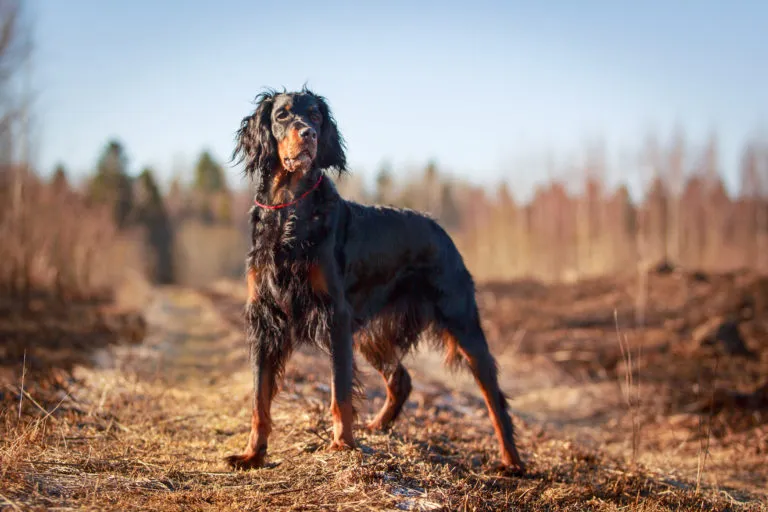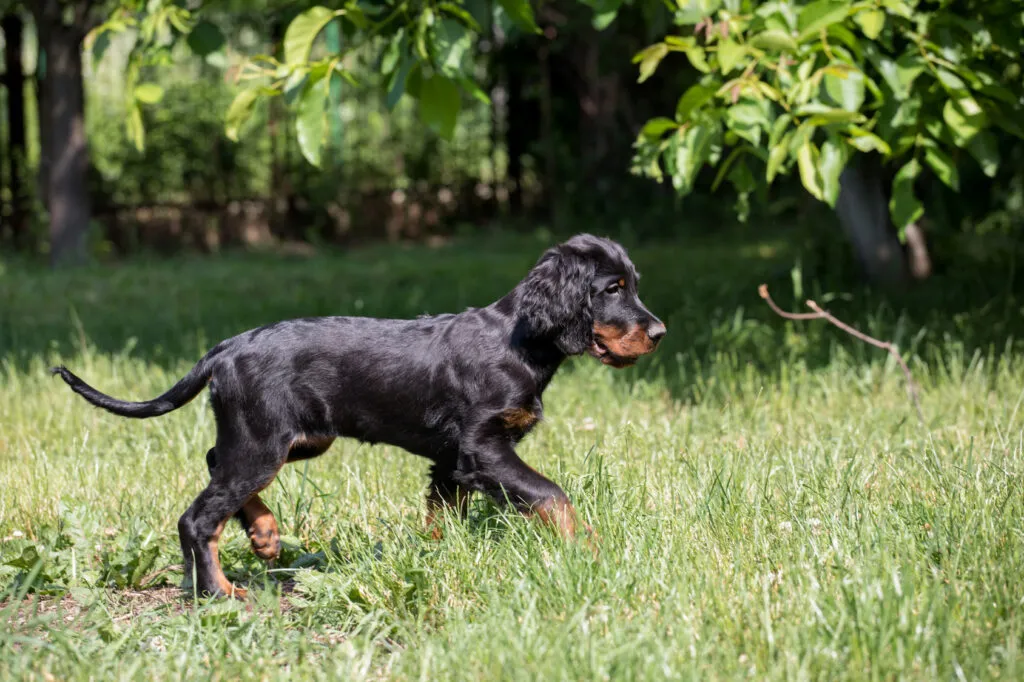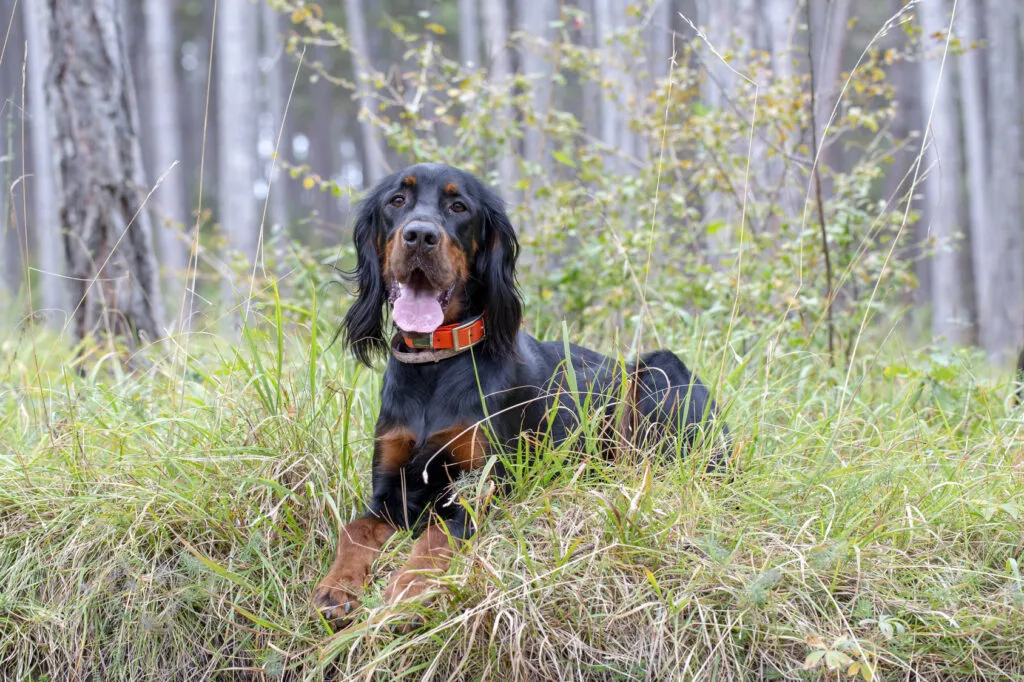Medium Size Poodle
The Gordon Setter is not only loved by hunters: this friendly, sporty Scotsman is a wonderful companion for nature lovers who already have dog experience and wish to spend lots of time outdoors with their four-legged friend.

© DragoNika / stock.adobe.com
The Gordon Setter is the heaviest and most robust of the setter breeds, known for its elegant black-and-chestnut coat, dynamic movement, and saber-shaped tail
Like all other setters, the robust Gordon Setter is immediately recognised as a good hunter: the body is dynamic and harmonious. The head is defined by a long rod with a pronounced stop. The long rod is either straight or slightly saber-shaped, carried horizontally to the top line or slightly lower.
At a maximum height of 66 cm at the withers, the Gordon Setter weighs about 25 to 35 kg, making it the heaviest of the setters.
The smooth fur is always deep black with chestnut markings. The Gordon Setter has medium-length fur, longer especially on the hanging ears, legs, and rod than on the rest of the body. Movement is powerful, and the Gordon Setter tracks with a high-raised rod.
As early as the 17th century, large, setter-like, black-and-tan dogs assisted hunters on the British Isles. The ancestors of the Gordon Setter were simply called Scottish Setters.
Duke Alexander of Richmond and Gordon was instrumental in the development of the Gordon Setter in the late 18th century.
The dog-loving hunter began the pure breeding of this setter at his Gordon Castle in Banffshire, Scotland. The Gordon Setter was well suited for hunting around the castle – the rugged Scottish Highlands. It was recognised as a separate breed by the British Kennel Club in 1924.
The name “Setter” is derived from the fact that setters, classified as pointing dogs, sit down when they detect game – usually birds such as pheasants. They then remain silent, pointing precisely in the direction of the game with an outstretched rod. Typically, they also lift a front paw.
The hunter can then give the command to flush and hunt the game. A Gordon Setter will then retrieve it reliably. When two Gordon Setters hunt together and the foremost assumes the pointing position, the second dog follows into the stance – this is called “backing”.
Besides the Gordon Setter, the category includes the English Setter, Irish Red and White Setter, and the Irish Red Setter.
All share a similar build and character traits, as well as the inherent pointing ability refined through selective breeding.
 © wip-studio / stock.adobe.com
© wip-studio / stock.adobe.com
Like many other setters, the Gordon Setter is a bold and confident hunter outside but often turns into a playful, affectionate dog at home. A well-exercised Gordon Setter is balanced, clever, and brave. It is very self-confident and hard to unsettle.
A Gordon Setter is not aggressive and loves being with its human family, including cuddling. Therefore, it is important that this dog is integrated into the family – kennel keeping is not an option! It gets along well with other dogs and pets within the family. It generally does well with children. \
However, it is reserved with strangers and does not appreciate being approached too quickly. Noteworthy is the breed’s significant need for movement, which must be considered: a Gordon Setter needs plenty of fresh air to satisfy its excellent sense of smell. Then it also enjoys essential rest periods with its human family much more.
As intelligent and lovely as the Gordon Setter is, it is not a suitable dog for beginners due to its very self-assured hunter nature. Training should be empathetic and consistent – the Gordon Setter needs clear leadership it can follow willingly.
A harshly treated Gordon Setter will lose trust in its leader. Controlling a Gordon Setter’s hunting instinct is challenging, especially with birds; professional training is essential. Even if kept as a family companion, it makes sense to undertake obedience training for hunting dogs.
Before your puppy arrives, look for dog schools with relevant experience.
The Gordon Setter, bred for robustness, is a dog breed that is not prone to breed-specific diseases. It’s crucial to choose a breeder whose parent dogs have been tested for hip dysplasia (HD) and to see the results in writing.
Besides unfavourable genetics, poor diet and exercise can also contribute to hip dysplasia. Occasionally, Gordon Setters may have eyelid deformities or the eye disease Progressive Retinal Atrophy (PRA). Reputable breeders work to prevent these issues. A Gordon Setter can live 12 to 14 years.
Like all dogs, the Gordon Setter needs a diet primarily from high-quality meat. Ensure meat is the first ingredient on the food label – whether feeding wet food or dry food. Feed young dogs three to four meals daily – older dogs need two meals a day. The energy needs of your dog depend on its activity level, so feeding recommendations are just guidelines.
Weigh your adult Setter every few weeks to manage weight. Active Gordon Setters seldom gain weight. If changing the diet, do so slowly to avoid sensitivities like diarrhoea or vomiting. After meals, always allow your dog to rest to aid proper digestion and prevent gastric torsion.
For treats, provide healthy snacks like freeze-dried treats, chewy items, or dental hygiene snacks for dogs. Ensure your dog always has access to fresh water.
The medium-length coat of the Gordon Setter requires regular coat care: brush your dog thoroughly at least once a week – this removes dead hairs and any debris from walks like burrs or small twigs and prevents tangles. Pay special attention to the areas behind the ears and underarms.
Part the hair while brushing to prevent knots at the base. It is advisable to comb your dog with a fine-toothed comb afterward. Be cautious with grooming tools that remove the undercoat – they can damage the Gordon Setter’s top coat and should be used carefully and knowledgeably.
Trim the longer hairs between the toes with thinning scissors. Bathe your dog once a month max., using a mild dog shampoo. Usually, dried dirt can be brushed out.
Regularly check your Gordon Setter’s hanging ears, as they can become inflamed due to the warm, moist climate inside. Clean the ears as needed with a specialist ear cleaner. Regularly check and trim your dog’s nails, especially if it moves less in old age or primarily on soft forest, grass, and field grounds, as nails may not wear down sufficiently.
 © As13Sys / stock.adobe.com
© As13Sys / stock.adobe.com
The Gordon Setter loves hunting and the success of the hunt. It is a versatile companion for two-legged hunters, suitable for flushing, searching, and retrieving. It works reliably in forest and field and is excellent at fetching.
If you cannot offer hunting experiences, you must provide alternative activities. Your Gordon Setter needs daily nature outings, even in bad weather. The adult Gordon Setter is an excellent jogging partner and can accompany you on bike rides or horses.
Its hunting passion requires you to always keep an eye on your dog to ensure it remains in sight and can be recalled. Introduce your dog to sports activities gradually. The Gordon Setter is also great for games of fetch or mantrailing – its outstanding sense of smell enjoys challenges and success in nose work.
Despite the adventures, remember the Gordon Setter also enjoys cuddling – use the rest periods to relax with your four-legged friend.
This nature lover thrives with people active outdoors and ideally sharing its hunting passion, such as hunters. It can also be happy in athletic families if provided with meaningful activities – plan ample time for your dog’s activities and coat care.
This setter can get along well with children – if they are used to treating animals respectfully, leading to lifelong friendships. It is understood that this breed does not fit well into city life. It is best suited to a house in the countryside – ideally with a fenced garden where it can freely roam.
Be aware that you are taking responsibility for a dog’s hopefully long life before bringing it home. This comes with daily time commitments and regular costs: besides the cost of purchase and basic equipment, expenses for vet, high-quality food, dog tax, and insurance will accrue.
A financial reserve for vet visits in case of illness should be available. Plan who will care for your Gordon Setter if you are sick or travelling. A very close bond with its person or family means it’s best cared for by known people – or simply taken on holiday!
Tip: a well-trained Gordon Setter is a wonderful companion for a walking holiday. Many hotels now warmly welcome four-legged guests.
The frequency of Gordon Setters varies greatly by country and region: English Setters are much more popular than Gordon Setters in the UK. So, even if you have to travel further or wait longer for the desired dog: buy your Gordon Setter only from a breeder affiliated with a dog breeding club and breeds with papers. This ensures you have a genuine Gordon Setter.
Responsible dog breeding involves health care, breeding with knowledge of type and character, and comprehensive socialisation – attributes not found in “bargain” dogs or with owners casually breeding their dogs. Always support responsible breeding of this unique breed. Your new family member can join you from eight weeks old – adhere to follow-up vaccination schedules.
If looking for an older Gordon Setter and wanting to provide a home to a homeless dog, check with animal welfare organisations – onsite and online. While the chance of finding a purebred setter is low, mixed setters with lots of charm can be available.
Investigate the background and traits carefully, because the energetic and lively hunting dogs or mixes can be challenging without proper training and education. Ensure the dog matches your lifestyle and experience.
Another option to find older Gordon Setters is through special setter clubs that help private owners or breeders rehome older setters – Gordon Setters may occasionally be available here.
We wish you much delight with your Scottish beauty!
Fans of the Bearded Collie agree that those who aren't familiar with this dog breed simply have to get acquainted with it. And those who have experienced how a Bearded Collie bolts across meadows with its flowing fur, how it rolls around full of energy and joy and how it attentively and observantly takes into account its owners wishes become simply addicted to this original dog breed and its unique charm.
The Goldendoodle isn't a breed, but a pairing between Golden Retrievers and Medium or Standard Poodles. Marketed as a low-maintenance dog for allergy sufferers, this hybrid is enjoying increasing popularity amongst dog lovers, similar to the Labradoodle.